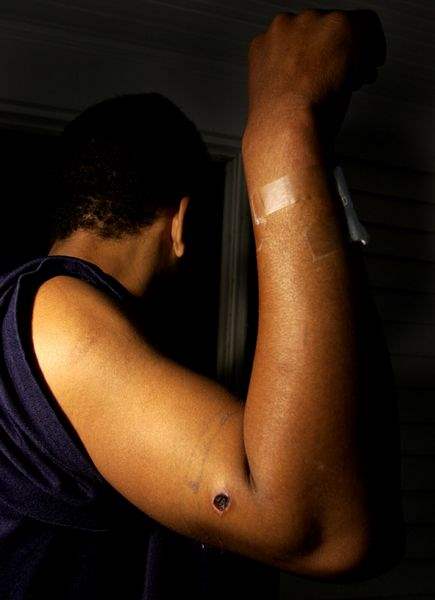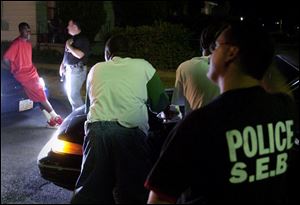
Upsurge in Toledo gang strife has police worried
7/14/2003
Justin Bradley was shot in the arm while sitting in a car in Toledo.
keese / blade
Justin Bradley considers himself the lucky one.
The 16-year-old only has two bullet holes in his arm - one where the shot pierced his arm by his elbow, the other where it exited his wrist.
His brother, Elondo Bradley, 19, took three bullets to the chest and one to his side when the two were shot while sitting in their car in central Toledo during what city police called a gang-related incident.
While the siblings claim they are not in a gang, they admit to being friends with members of the Bloods. Police say both brothers were wearing red - the Bloods' gang colors - and were in rival Crips gang territory waiting for friends to pay a cell phone bill when they were fired upon in broad daylight. Justin said he was wearing an Ohio State shirt.
“We was in the wrong 'hood,” Elondo said. “I knew stuff was going on. I didn't know it was that bad.”
His younger brother agreed, saying the streets are getting more dangerous.
“If you aren't known in the areas, you get popped,” Justin said. “It's hot out here. It ain't safe out here.”
Recent increased gang activity - which has included two murders and at least a handful of other shootings involving rival gangs, including one Friday afternoon - have raised the concern of police, criminal-justice authorities, city officials, and community members.
Mayor Jack Ford gathered a group together last week to talk about short-term and long-term ways to manage the bloodshed and help affected neighborhoods.
“We had several gang-related homicides recently, and we're deeply concerned. We don't want this to continue,” the mayor told the group.
While police said the violence has a long way to go before it escalates to the level of the mid-1990s when drive-by shootings and other overt violence were common, they're concerned about the recent increase in shootings.
Elondo Bradley said the recent crimes may be about turf disputes, but authorities said differences between gangs often are sparked by other issues, such as drugs, women, and disrespect.
“Things are starting to get a lot more violent,” Detective Keith Zaborowski of the police's gang task force told The Blade “It's starting to resemble the violent days of old, but I hope it slows down.”
Police Chief Mike Navarre agreed, but said he does not think this year will be as bad as nearly a decade ago.
“The types of shootings we saw then were much more heinous, and there were some real, real violent people,” he said. “Now I'm seeing a lot of senseless shootings over arguments.”
To deal with the violence in the short-term, authorities plan to ask former gang members to get together and discuss the current situation. City police and criminal-justice officials also plan to share more information about members within , especially those coming out of a detention facility.

Detective Bill Noon, left, questions a young man at Lincoln Avenue and Ray Street, while Detective Keith Zaborowski monitors others at the scene. Both are with the Gang Task Force.
Mayor Ford wants to collect more data on gangs in an information clearinghouse. Chief Navarre said there are 100 to 150 very active gang members and a “huge number” who are on the fringes.
In March, Sgt. Chris Delaney, a former gang task-force member, said there were five gangs whom detectives were dealing with on a daily basis and an estimated 250 to 500 active gang members in the city.
Police are trying to keep tabs on these people by patrolling known gang areas, making traffic stops, and gathering information, such as possible venues for retaliation.
Last week, gang task-force members stopped three men at the intersection of Ray Street and Lincoln Avenue, where neighbors have reported alleged gang members gathering and selling drugs.
“Pass along to all your friends not to hang around down here,” Detective Zaborowski told the men after they were patted down and checked for warrants.
He and his colleagues are trying to suppress gang-related activity in this and other neighborhoods in addition to gathering information about gang members and arresting them on drugs and weapons offenses. But that has been a little tough recently.
Neutral spots where gang members hang out have been empty since the June 22 murder of 25-year-old David Davis at the BP gas station on Detroit Avenue in central Toledo. Businesses at bars where gang members are known to frequent also has slowed, said Detective Bill Noon.
Those who attended the mayor's meeting said in addition to short-term solutions, something must be done in the long term to deal with the gang situation and to help current and potential members find a different way of life.
“We are one of the only cities in Ohio still perpetrating this gang stuff,” said J.R. Robinson of Connecting Point's Focus on the Future program.
Some suggested the criminal justice system needs to take a tougher stand on the matter. Others said locking everyone up isn't going to solve the problem.
“We can't criminalize everyone. Not all of these people are criminals,” said Jared Cook, a board member of the Tavis Smiley Foundation, which helps educate young people, especially African-Americans. “These kids are victims of society.”
Chief Navarre agreed.
“In many respects, we're talking about a way of life for young people and not just the crimes being committed,” he said.
The chief said the community needs to let the young people know “this way of life is not acceptable.” Many gang members don't have jobs or attend school. To help prevent youth from joining gangs, community members should mentor them and provide them job and recreational opportunities, meeting attendees agreed.
Elondo Bradley said he grew up around gangs and was raised in a Blood neighborhood. He said he adapted to his surroundings and made friends with people “you expect to have your back” if trouble arises.
When he was younger, he said he wanted to be part of a gang. But as he got older, he changed his mind. He said once you are part of a gang, it's difficult to change your lifestyle.
“There's no way out,” he said. “It's only jail or dead.”